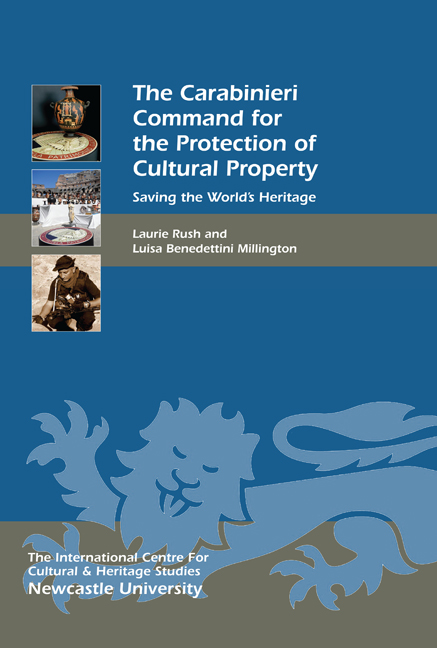Book contents
- Frontmatter
- Contents
- List of Illustrations
- Acknowledgments
- Foreword (in English and in Italian): Brigadier General Mariano Mossa
- Prefazione
- Abbreviations
- 1 The Carabinieri TPC: an Introduction and Brief History. Perché l’Italia? Why Italy?
- 2 Headquarters, the Databank and Operative Department in Rome
- 3 Carabinieri Public Outreach and Education
- 4 Central Italy and the Adriatic: Lazio, Florence, Bologna and Ancona
- 5 Activities in the North: Genova, Monza, Torino and Venezia
- 6 The Regional Offices: Naples, Bari and the South
- 7 The Challenges of the Island Regions: Sicily, Sardinia and the Palermo, Siracusa and Sassari Nuclei
- 8 Investigation Techniques
- 9 Repatriation of Works of Art to Italy: From Siviero to the Medici Conspiracy
- 10 Fakes, Forgeries and Money Laundering
- 11 Who Are the Officers of the Carabinieri TPC?
- 12 The Carabinieri, Peacekeeping and Foreign Relations: The Carabinieri Mission to Iraq
- 13 ‘The Italian Model’
- Bibliography and References
- About the Authors
- Index
- Heritage Matters
9 - Repatriation of Works of Art to Italy: From Siviero to the Medici Conspiracy
Published online by Cambridge University Press: 21 May 2021
- Frontmatter
- Contents
- List of Illustrations
- Acknowledgments
- Foreword (in English and in Italian): Brigadier General Mariano Mossa
- Prefazione
- Abbreviations
- 1 The Carabinieri TPC: an Introduction and Brief History. Perché l’Italia? Why Italy?
- 2 Headquarters, the Databank and Operative Department in Rome
- 3 Carabinieri Public Outreach and Education
- 4 Central Italy and the Adriatic: Lazio, Florence, Bologna and Ancona
- 5 Activities in the North: Genova, Monza, Torino and Venezia
- 6 The Regional Offices: Naples, Bari and the South
- 7 The Challenges of the Island Regions: Sicily, Sardinia and the Palermo, Siracusa and Sassari Nuclei
- 8 Investigation Techniques
- 9 Repatriation of Works of Art to Italy: From Siviero to the Medici Conspiracy
- 10 Fakes, Forgeries and Money Laundering
- 11 Who Are the Officers of the Carabinieri TPC?
- 12 The Carabinieri, Peacekeeping and Foreign Relations: The Carabinieri Mission to Iraq
- 13 ‘The Italian Model’
- Bibliography and References
- About the Authors
- Index
- Heritage Matters
Summary
Italian works of art are an integral part of western and of world civilisation as a whole. They are signposts along the road to civilisation. To steal them is to deny the foundation of a nation's culture. Their return is an act of justice.
Susanna Agnelli, Minister of Foreign Affairs, Italy, quoted in her introduction to ‘Treasures Untraced, An Inventory of the Italian Art Treasures Lost during the Second World War’.The Medici Case is not the first time in recent history that Italy has suffered a massive theft of artworks and antiquities, and it is reasonable to question whether mid-20th-century experiences have influenced current Italian approaches to repatriation. Analysis of the case of Rodolfo Siviero and his efforts to find and return cultural property stolen from Italy during World War II offers additional historical context for appreciating the approaches and efforts of the Italian Foreign Ministry and the Carabinieri TPC of today.
RODOLFO SIVIERO AND WORLD WAR II REPATRIATION
From the period beginning on 3 September 1943, when the Italians signed an armistice with the Allies, until May 1945, when German forces in Italy surrendered, German forces – even as an army in retreat – helped themselves to an extraordinary number of artworks belonging to individual Italian citizens, public and private collections and parishes of the Roman Catholic Church. To some extent, the theft of art from the Italian people had begun even before 1943, as Adolf Hitler had pressured Mussolini to sell him Italian masterpieces he coveted, such as the sculpture DiscobolusLancellotti, the 1st-century marble copy of the famous Greek bronze Discobolus of Myron. The sale of such objects was in direct violation of Italian cultural property law. In addition, agents working for the German government prior to the declaration of war carefully inventoried art treasures throughout Europe, preparing lists of desired objects for museums and personal ownership in the Third Reich.
As the Allied invasion of Italy began, a controversial individual emerged in the world of heritage in conflict. Born in 1911 in Guardistallo (Pisa), Rodolfo Siviero was the son of the Maresciallo (marshall) commander of the local detachment of the Carabinieri Corps and grew up in Florence.
- Type
- Chapter
- Information
- The Carabinieri Command for the Protection of Cultural PropertySaving the World's Heritage, pp. 127 - 140Publisher: Boydell & BrewerPrint publication year: 2015



